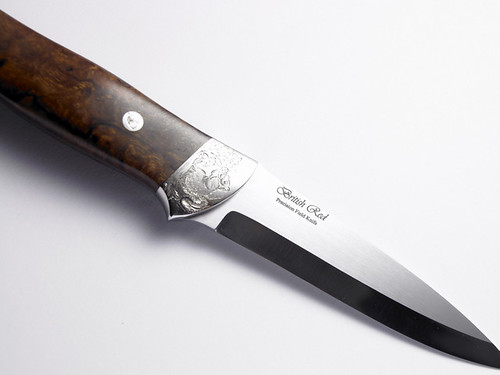Stuart Mitchell "Survival Knife" Prototype (Pic Heavy)
- Thread starter Nightfly
- Start date
-
Come along to the amazing Summer Moot (21st July - 2nd August), a festival of bushcrafting and camping in a beautiful woodland PLEASE CLICK HERE for more information.
You are using an out of date browser. It may not display this or other websites correctly.
You should upgrade or use an alternative browser.
You should upgrade or use an alternative browser.
Apologies for the delay in getting this up. I've been a bit busy.
First impressions of the knife when I unwrapped it was a certain cool factor to the design. In a world where almost every knife design has been made or seen, it was refreshing to see something a little different and what I'd consider modern and quirky.
The knife came in a generic kydex sheath. Not the design it will eventually be seen in as this was a quick job just to house the knife on its initial test period.
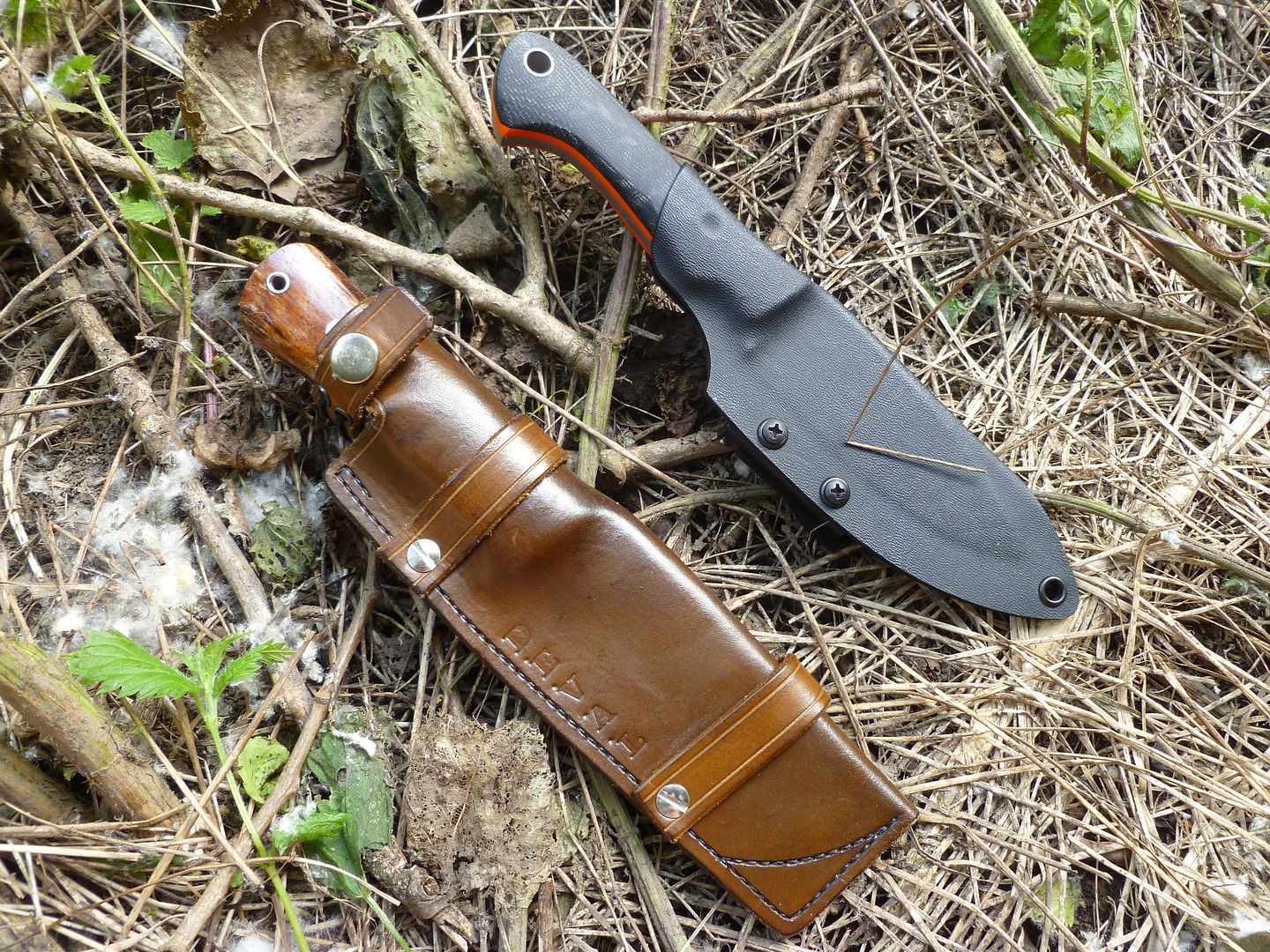
I'm putting the knife side by side with my Stuart Mitchell DB in these pictures for a good reason I'll get down to near the end because I've been using my DB alot in Africa recently, moreso than usual and it had a direct effect on my use of the SM Survival. Pictures of the knife in use have been catalogued very well in this thread anyway, and I'd just be repeating other posts as it performs all tasks very well, from food prep to feathersticks, tool making and tree batonning.
Obviously, as you'd expect from Mr Mitchell, the quality of construction and attention to detail are at the top of the handmade knife game. We all know and expect that from Stu, so I don't need to go into more detail there.
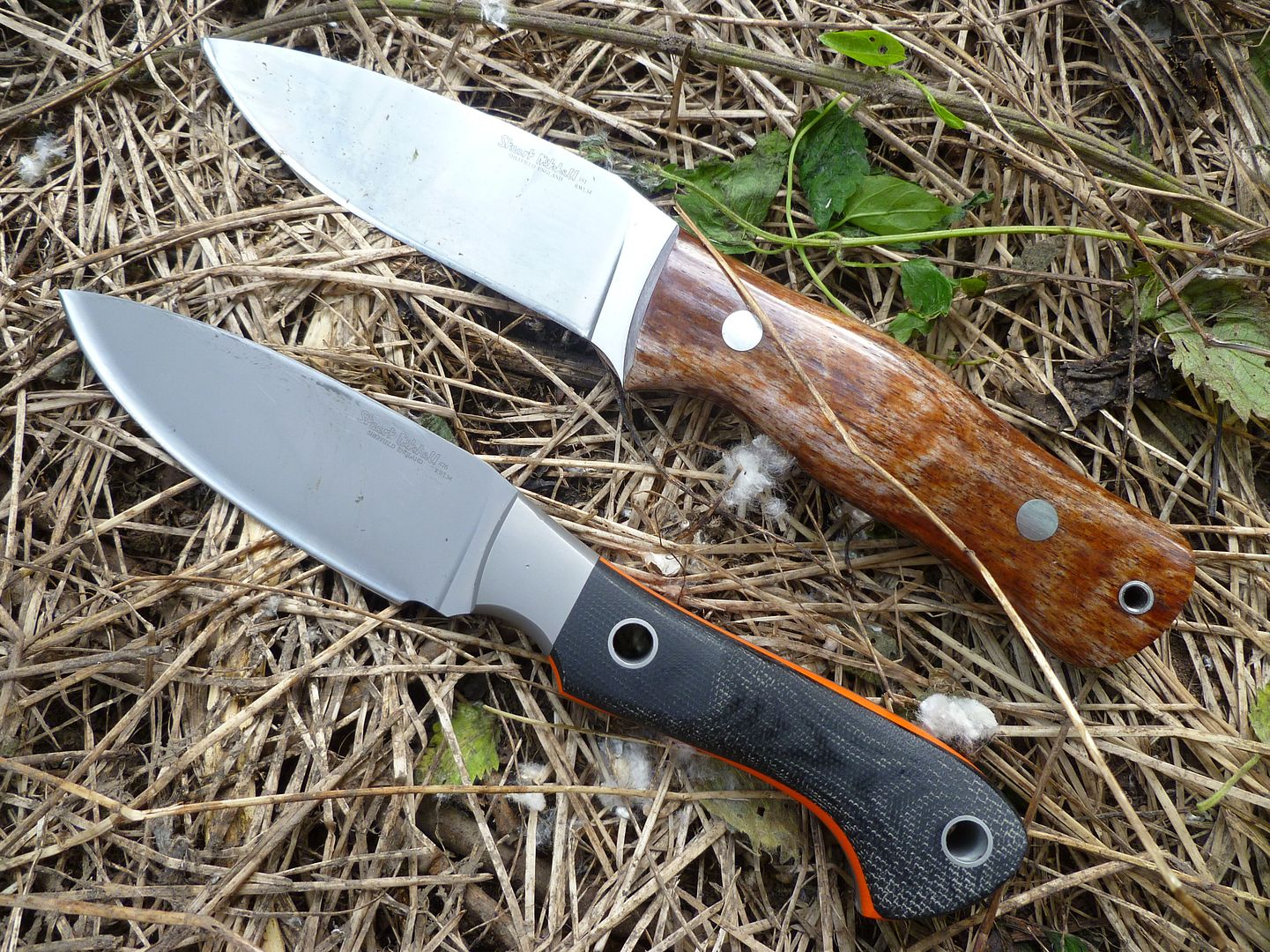
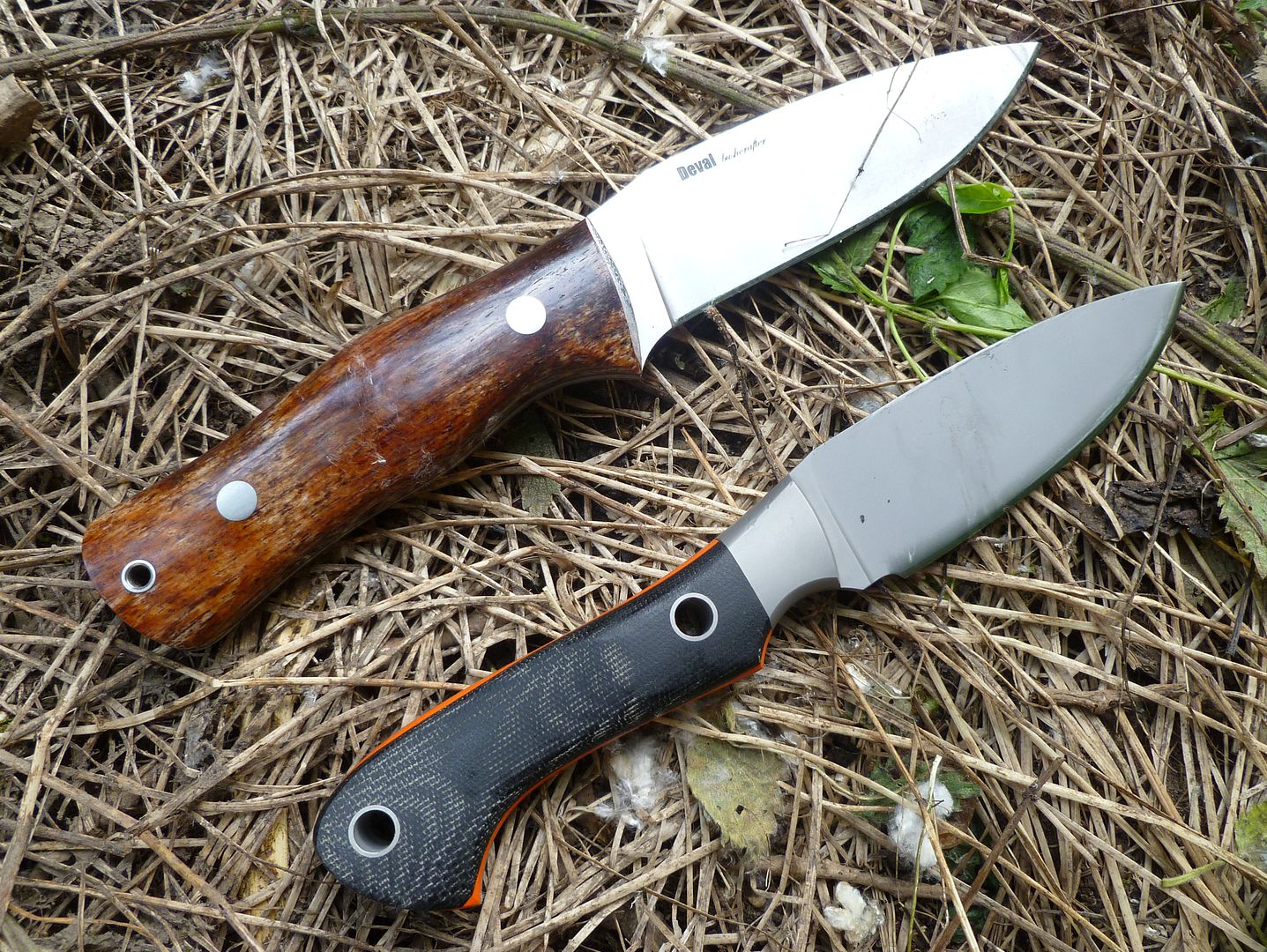
When Stu sent me the knife, he re-finished it with a highly polished convex edge...
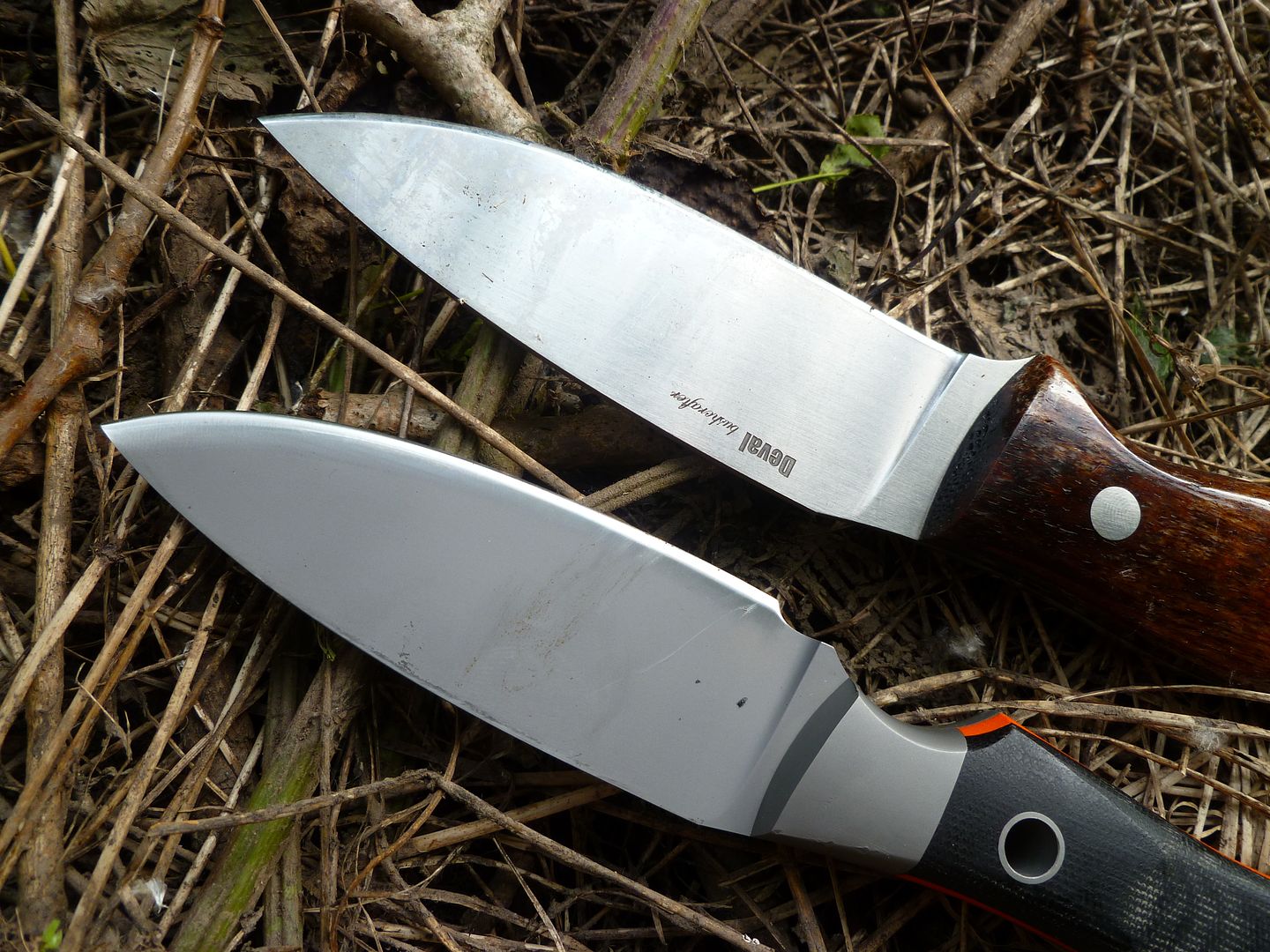
The blade shape and thickness are perfect for a robust multi use, multi tasking knife. The only thing I would personally change (and this has aleady been addressed and will be on the MK II), is the gap between the choil and the knife edge. It needs to come forward right to the edge of the choil. Whether it needs a slight protruberence to protect the bulging flesh of a gripping finger from creeping over onto the blade during a stabbing motion is something I've pondered over. It is a survival knife, so such an action in an emergency if stranded in an area where wild game is abundant, it is certainly possible you may need to use it in that fashion. During my time in Africa, I've seen that this may be a very real danger, even in safer places with other people. So food for thought there.
The overall length of the knife is compact and about the same as any of the well known smaller utility knives we all know about. In my opinon a survival knife needs to be small, otherwise it is more often than not left in a pack or basecamp. Not great when you are cut off from those places and in real need of a survival blade. It is however quite heavy because of the bolsters and blade thickness. It is a strong knife, so whether strength would be sacificed too much with lightening the whole thing is maybe something Stu can answer. I certainly wouldn't want to weaken a knife your life may depend on.
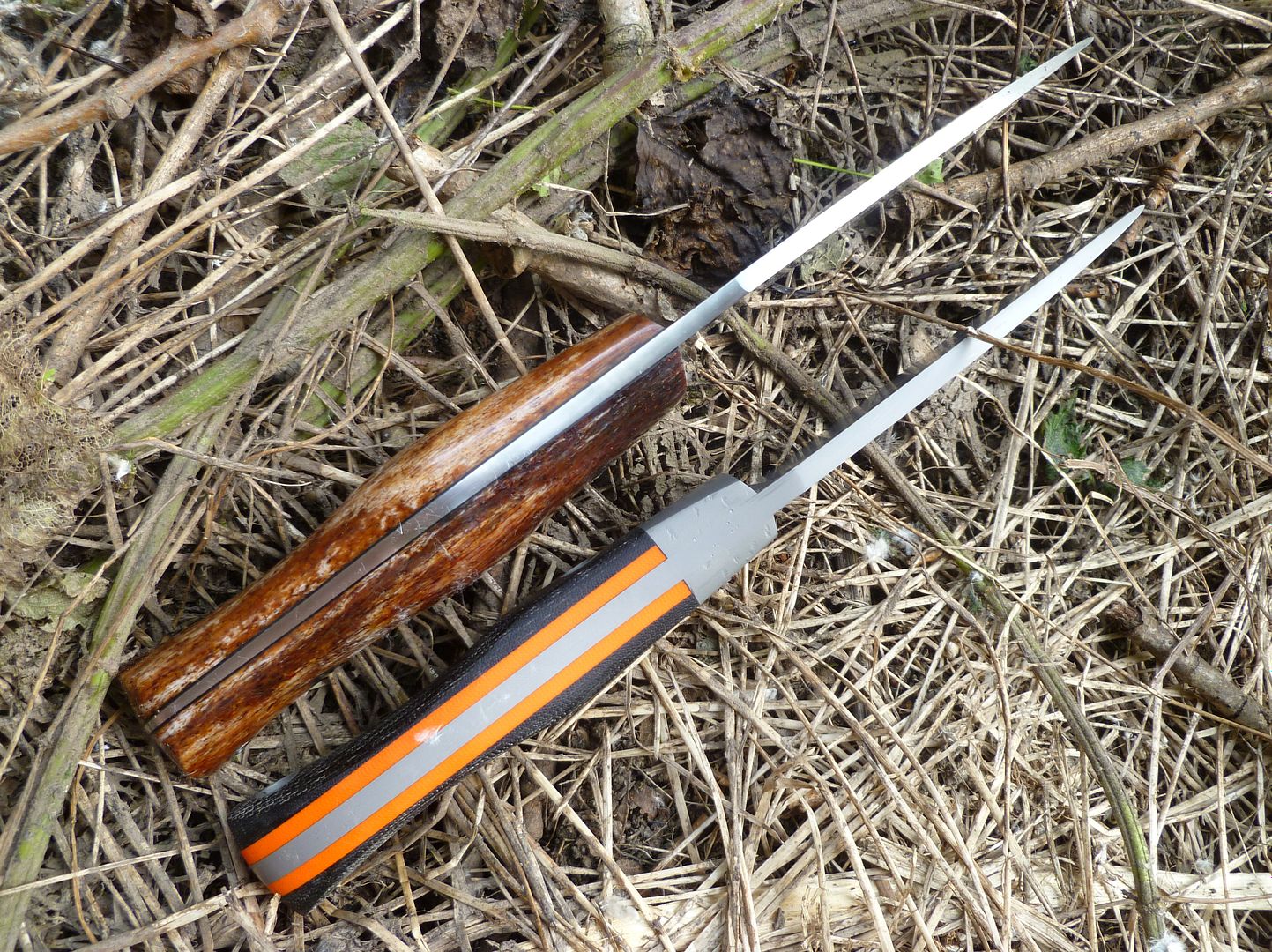
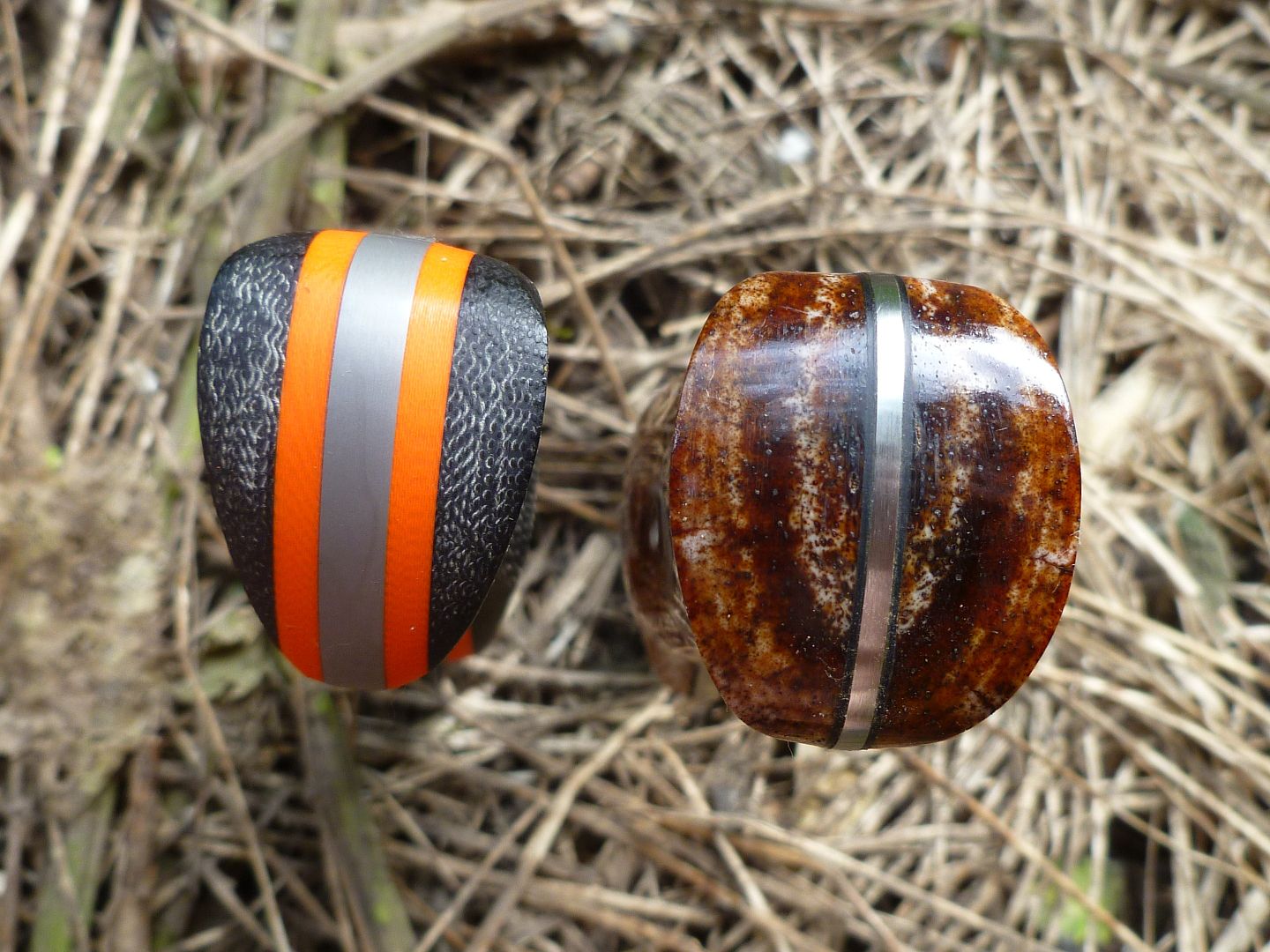
The handle profile as you can see is quite thick. My DB is very thick to aid in prolonged use and comfort. Something that can be sacrificed slightly in a survival knife. The butt has a significant amount of surface area which is great if you need to pound something. I would like to see a couple of MM of steel protruding beyond the scales as this would protect them somewhat and prevent too much force from impacting or splitting them. Perhaps a more pronounced convex shape would also achieve this. Again, this is something I would want to test as I'm speculating. Unfortunately I wasn't able to with this knife, but Stu will be supplying me with another blade I can really batter in a full on extreme field test.
On handling and using the knife over a period of about an hour - just sitting down and whittling a stick to get used to it, I found that the lanyard hole that sits below the palm pad of my first finger started to cause a burning blister. This obviously is down to the positioning, but was caused by the whole knife constantly pivoting in my palm. The way the handle is shaped where my index and second finger rest wouldn't allow me to grip it in a way to stop in moving. The rear of the handle I could grip firmly, but the front moved up and down however hard I gripped it. Something at the front just prevented me from securing it in my hand sufficiently. On laying it over my own knife, it's not difficult to see why. I need a touch more bulk for my index finger.
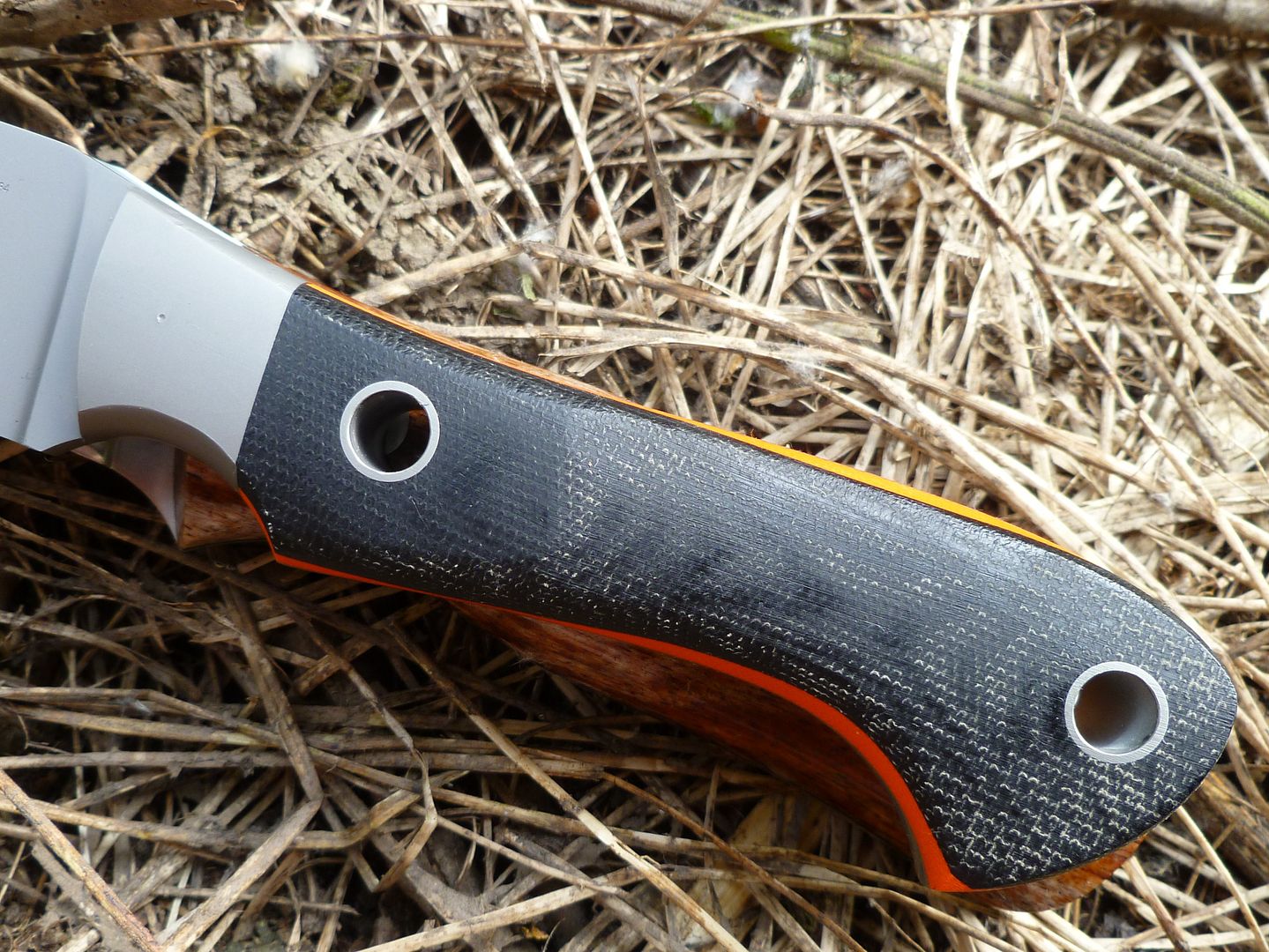
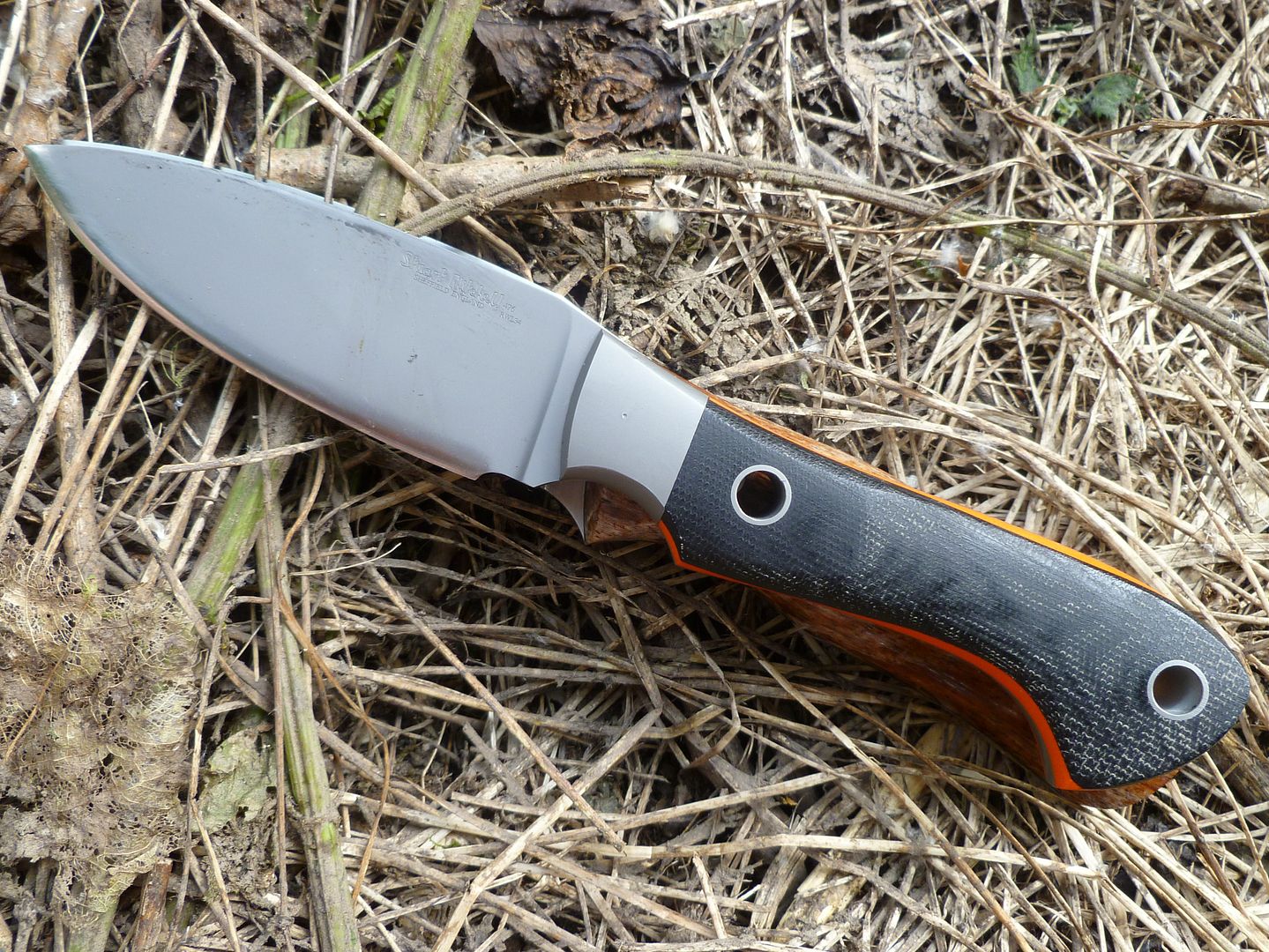
The majority of the handle just goes in and out in exactly the opposite places to my knife. So although I could easily have the handle being much flatter, the tang for me needs to be higher and beefier at the front choil area.
This is the reason I have pictured the knives together. I try to be honest and impartial in my reviews, and it's a no brainer that the first inch of handle just doesn't work at all for me. But we are all different and the DB has evolved from what used to be purely a weekend bushcrafter knife, into a tool I take with me for much more than wood working and countryside bimbling. I used to work for Rolex and spend all my time in the cities of the UK with a Mont Blanc pen as my main tool. Now I'm a field herpetologist and I'm always outdoors with a knife and a snake hook, and over the last four months, I've been using my DB more than most Brits have been using a brolly. My own personal DB handle is also too much for most people and doesn't work for them as I have a wide palm and long fingers, which is why Stu makes a slimline version for his normal customers. So his new survival knife handle is going to work for the majority of people. And not just as a survival knife either, but an everyday outdoorsmans knife. It is robust to the point that I know I can beat on it with rocks, railway sleepers and god knows what else.
So in short, im looking forward to the MKII with the closer edge to the choil, and to see what other changes Stu makes from the input of others testing it. If indeed, any are needed. It's a beautifully crafted and well designed knife even in its prototype form.
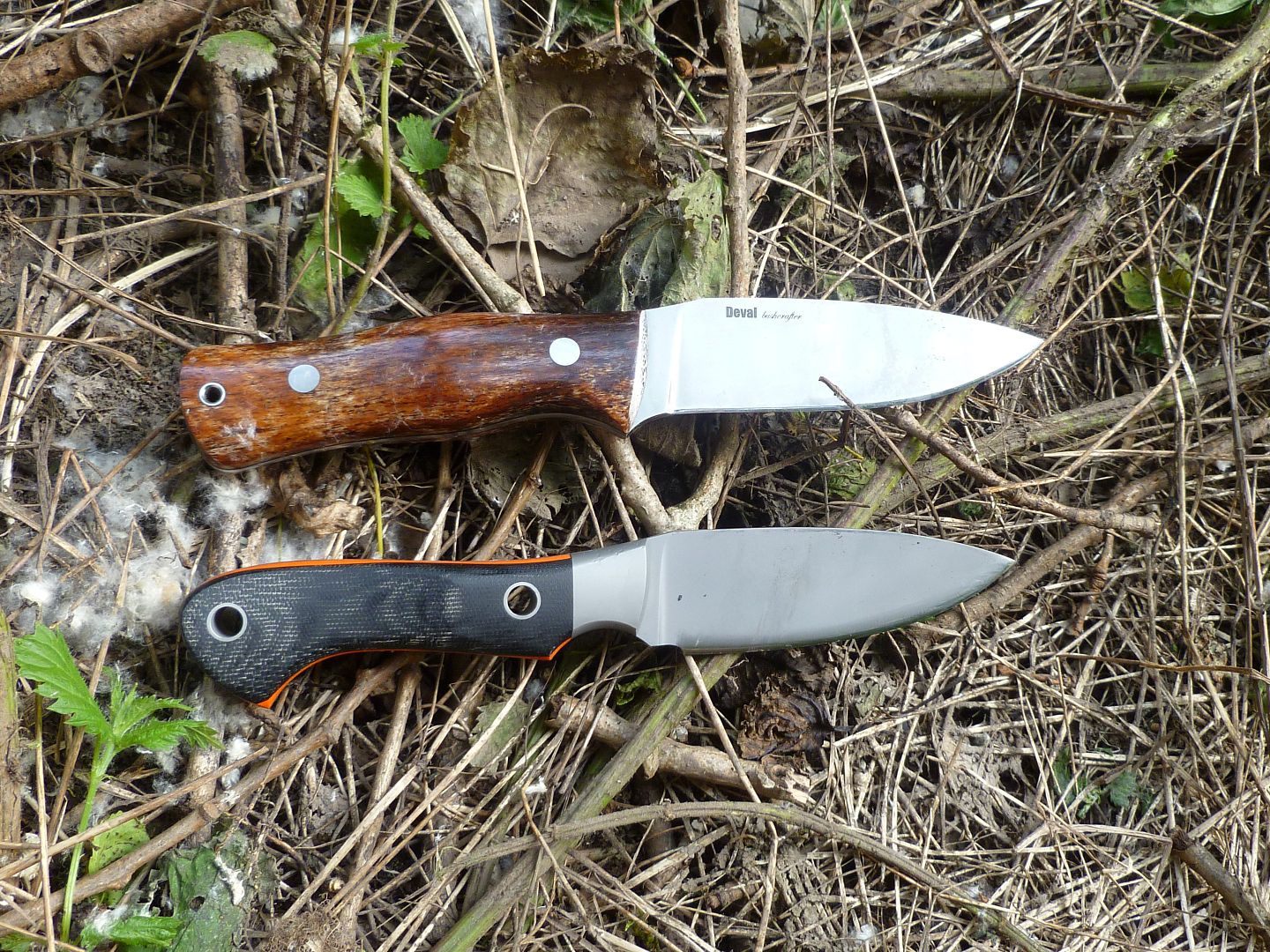
First impressions of the knife when I unwrapped it was a certain cool factor to the design. In a world where almost every knife design has been made or seen, it was refreshing to see something a little different and what I'd consider modern and quirky.
The knife came in a generic kydex sheath. Not the design it will eventually be seen in as this was a quick job just to house the knife on its initial test period.

I'm putting the knife side by side with my Stuart Mitchell DB in these pictures for a good reason I'll get down to near the end because I've been using my DB alot in Africa recently, moreso than usual and it had a direct effect on my use of the SM Survival. Pictures of the knife in use have been catalogued very well in this thread anyway, and I'd just be repeating other posts as it performs all tasks very well, from food prep to feathersticks, tool making and tree batonning.
Obviously, as you'd expect from Mr Mitchell, the quality of construction and attention to detail are at the top of the handmade knife game. We all know and expect that from Stu, so I don't need to go into more detail there.


When Stu sent me the knife, he re-finished it with a highly polished convex edge...

The blade shape and thickness are perfect for a robust multi use, multi tasking knife. The only thing I would personally change (and this has aleady been addressed and will be on the MK II), is the gap between the choil and the knife edge. It needs to come forward right to the edge of the choil. Whether it needs a slight protruberence to protect the bulging flesh of a gripping finger from creeping over onto the blade during a stabbing motion is something I've pondered over. It is a survival knife, so such an action in an emergency if stranded in an area where wild game is abundant, it is certainly possible you may need to use it in that fashion. During my time in Africa, I've seen that this may be a very real danger, even in safer places with other people. So food for thought there.
The overall length of the knife is compact and about the same as any of the well known smaller utility knives we all know about. In my opinon a survival knife needs to be small, otherwise it is more often than not left in a pack or basecamp. Not great when you are cut off from those places and in real need of a survival blade. It is however quite heavy because of the bolsters and blade thickness. It is a strong knife, so whether strength would be sacificed too much with lightening the whole thing is maybe something Stu can answer. I certainly wouldn't want to weaken a knife your life may depend on.


The handle profile as you can see is quite thick. My DB is very thick to aid in prolonged use and comfort. Something that can be sacrificed slightly in a survival knife. The butt has a significant amount of surface area which is great if you need to pound something. I would like to see a couple of MM of steel protruding beyond the scales as this would protect them somewhat and prevent too much force from impacting or splitting them. Perhaps a more pronounced convex shape would also achieve this. Again, this is something I would want to test as I'm speculating. Unfortunately I wasn't able to with this knife, but Stu will be supplying me with another blade I can really batter in a full on extreme field test.
On handling and using the knife over a period of about an hour - just sitting down and whittling a stick to get used to it, I found that the lanyard hole that sits below the palm pad of my first finger started to cause a burning blister. This obviously is down to the positioning, but was caused by the whole knife constantly pivoting in my palm. The way the handle is shaped where my index and second finger rest wouldn't allow me to grip it in a way to stop in moving. The rear of the handle I could grip firmly, but the front moved up and down however hard I gripped it. Something at the front just prevented me from securing it in my hand sufficiently. On laying it over my own knife, it's not difficult to see why. I need a touch more bulk for my index finger.


The majority of the handle just goes in and out in exactly the opposite places to my knife. So although I could easily have the handle being much flatter, the tang for me needs to be higher and beefier at the front choil area.
This is the reason I have pictured the knives together. I try to be honest and impartial in my reviews, and it's a no brainer that the first inch of handle just doesn't work at all for me. But we are all different and the DB has evolved from what used to be purely a weekend bushcrafter knife, into a tool I take with me for much more than wood working and countryside bimbling. I used to work for Rolex and spend all my time in the cities of the UK with a Mont Blanc pen as my main tool. Now I'm a field herpetologist and I'm always outdoors with a knife and a snake hook, and over the last four months, I've been using my DB more than most Brits have been using a brolly. My own personal DB handle is also too much for most people and doesn't work for them as I have a wide palm and long fingers, which is why Stu makes a slimline version for his normal customers. So his new survival knife handle is going to work for the majority of people. And not just as a survival knife either, but an everyday outdoorsmans knife. It is robust to the point that I know I can beat on it with rocks, railway sleepers and god knows what else.
So in short, im looking forward to the MKII with the closer edge to the choil, and to see what other changes Stu makes from the input of others testing it. If indeed, any are needed. It's a beautifully crafted and well designed knife even in its prototype form.

Last edited:
Saw this reveiw on british blades, and its a great knife love the lines and how it flows, a survival knife and not a seration or sawback in sight thank the lord!
thanks for the review very nice knife indeed.
how would you compare it with the ka-bar bk2 ? http://www.kabar.com/knives/detail/1 if they can be comparable at all...
I was impressed by the thickness of this knife as well as the bk2. Any comment of the effect of the thickness of this blade (and in general in every knife)?
thanks again
P.
how would you compare it with the ka-bar bk2 ? http://www.kabar.com/knives/detail/1 if they can be comparable at all...
I was impressed by the thickness of this knife as well as the bk2. Any comment of the effect of the thickness of this blade (and in general in every knife)?
thanks again
P.
Hi all, as the thread title suggest the knife in here was a prototype, through various field test by various users a set of useful modifications were identified, so a MkII, addressing these has been made...
The changes....
1: The edge was to be brought back, slightly intersecting the finger notch, bringing that valuable business end, right by the grip, right where you need it...
2: The bolster was to get a through hole, 1/4" is as much as I can safely get in there, bearing in mind there are 4 x 1/8" pins in there too, 1/4" is ample there though...
3: A satin finish, not the blasted one, for the blade...
4: The most important for me and one I was keen to see work, I wanted to introduce a more Busse like tube/fixing, the Proto relied on epoxy, I was looking for belt and braces here... I didn't want a full flared Busse style, more a cross between where we were and the Busse, the tubes in 'Secare' are 10mm stainless, 0.8mm walled, slightly flared into those recesses in the Micarta, the recess cause no discomfort, if anything they add grip...
This particular mod was the cause of some thought by me, you see it's not exactly straight forward to do in a handle with so much shaping, all done by hand, the grip really needs shaping and finishing pre adding the tubes, to enable this I was reliant on epoxy only, no mechanical fastenings in the scales at all, for much of the build...
Here's it pre tubes...

I was quite impressed by that, just the epoxy, it even survived a drop...
From there though, countersink the Micarta, squeeze the tubes into place with a wipe of more epoxy then flare the ends, that 0.8mm walled tube takes some flaring, it is not minded to go back without a fight, the whole thing is very, very strong...
So, here's it, 'Secare'...
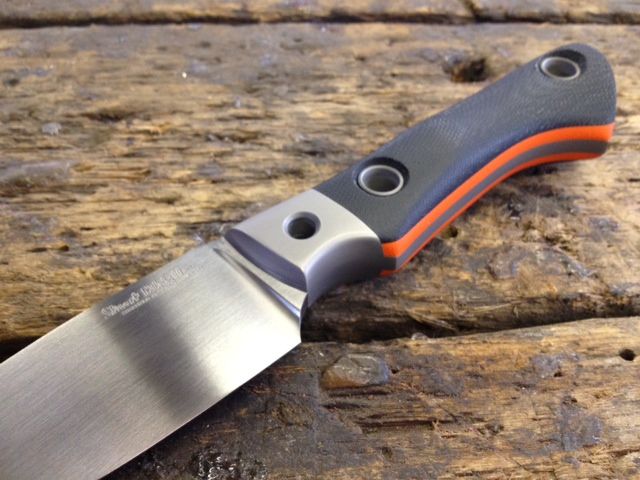
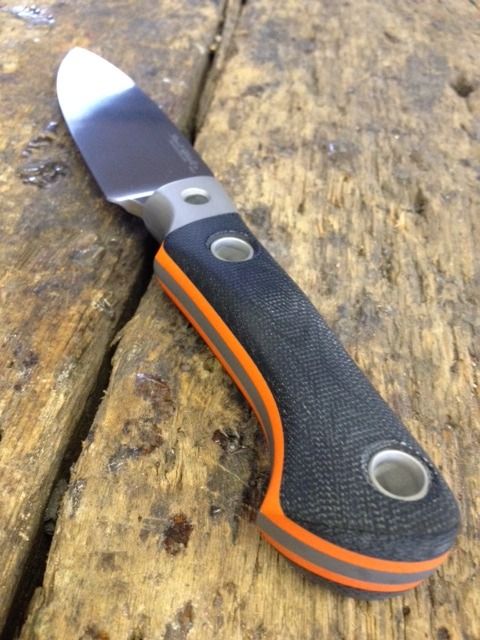
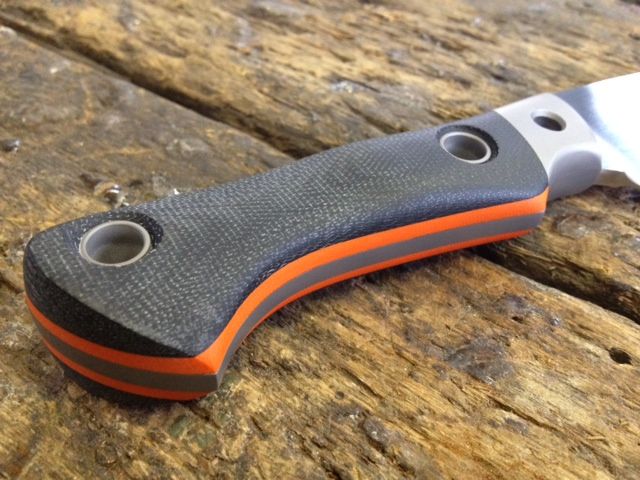
And here's why I was keen for the bolster hole to be 1/4", two thickness's of Paracord...

The changes....
1: The edge was to be brought back, slightly intersecting the finger notch, bringing that valuable business end, right by the grip, right where you need it...
2: The bolster was to get a through hole, 1/4" is as much as I can safely get in there, bearing in mind there are 4 x 1/8" pins in there too, 1/4" is ample there though...
3: A satin finish, not the blasted one, for the blade...
4: The most important for me and one I was keen to see work, I wanted to introduce a more Busse like tube/fixing, the Proto relied on epoxy, I was looking for belt and braces here... I didn't want a full flared Busse style, more a cross between where we were and the Busse, the tubes in 'Secare' are 10mm stainless, 0.8mm walled, slightly flared into those recesses in the Micarta, the recess cause no discomfort, if anything they add grip...
This particular mod was the cause of some thought by me, you see it's not exactly straight forward to do in a handle with so much shaping, all done by hand, the grip really needs shaping and finishing pre adding the tubes, to enable this I was reliant on epoxy only, no mechanical fastenings in the scales at all, for much of the build...
Here's it pre tubes...

I was quite impressed by that, just the epoxy, it even survived a drop...
From there though, countersink the Micarta, squeeze the tubes into place with a wipe of more epoxy then flare the ends, that 0.8mm walled tube takes some flaring, it is not minded to go back without a fight, the whole thing is very, very strong...
So, here's it, 'Secare'...



And here's why I was keen for the bolster hole to be 1/4", two thickness's of Paracord...

Right now, the one you see there is a commission so sold...That is a stunning looking knife. When will it be available Stuart?
Email is your best bet...
Glowing review,
I know I should have paid more attention in school,
Perhaps I'd be in a profession where I could afford such a tool.
A very well thought out handle and blade, of finest craftsmanship its certainly been made.
Of use to folk with jobs at each end of t'scale , from some that use a hook for a snake to some that may use just an old garden rake.
Yes its alot of hard earned cash, but how many tools can you carry to cut, scrape, pierce , baton, lever and lash ?
So would I part wi my very own brass ? Unfortunately no, for I'd end up baht company of my lovely lass
Chiseller
Sent from my HTC One X using Tapatalk 2
I know I should have paid more attention in school,
Perhaps I'd be in a profession where I could afford such a tool.
A very well thought out handle and blade, of finest craftsmanship its certainly been made.
Of use to folk with jobs at each end of t'scale , from some that use a hook for a snake to some that may use just an old garden rake.
Yes its alot of hard earned cash, but how many tools can you carry to cut, scrape, pierce , baton, lever and lash ?
So would I part wi my very own brass ? Unfortunately no, for I'd end up baht company of my lovely lass
Chiseller
Sent from my HTC One X using Tapatalk 2
The MkII version of Secare was finished yesterday and is currently on its way to be sheathed.
Stu sent me these pictures to hold me over until I get the chance to look over and try out the differences between the prototype in the review and this one.
I'll post some more when that moment arrives!






Stu sent me these pictures to hold me over until I get the chance to look over and try out the differences between the prototype in the review and this one.
I'll post some more when that moment arrives!






It's a beautiful piece of work and design. But one wonders what that hideous blob is on the reverse of the blade  okenest:
okenest:
It's a beautiful piece of work and design. But one wonders what that hideous blob is on the reverse of the bladeokenest:
Yes, it is a bit out of focus but Stu marks all of his knives with his name and steel selection

Yes, it is a bit out of focus but Stu marks all of his knives with his name and steel selection
 .
.Martin Swinkels did the sheath for this one. The partial orange liners are mostly hidden by kydex but still perform the task of relocating the knife in snow etc. very well.
The smaller hole through the bolster houses a 18mm Scout firesteel. It is small, but still long enough to get a decent grip. Clear lacquer seals it in, you need to use a stick or a stone to dislodge it. The idea is to only use it in a pinch (after use it won't fit as snugly anymore either).
Size comparison against a Bayley S4. Thanks for looking!






The smaller hole through the bolster houses a 18mm Scout firesteel. It is small, but still long enough to get a decent grip. Clear lacquer seals it in, you need to use a stick or a stone to dislodge it. The idea is to only use it in a pinch (after use it won't fit as snugly anymore either).
Size comparison against a Bayley S4. Thanks for looking!






Wow, that is very nice indeed. Want one, or two, heck, I want a draw full
Thats a fascinating project - lots of new features, and an original design with lots of thought and expert reviews. Great work
Great read to follow the development there. Cheers for sharing that. Personally I don't like the bright orange but its a stunner all the same.
Similar threads
- Replies
- 23
- Views
- 849
- Replies
- 3
- Views
- 303
- Replies
- 0
- Views
- 162
- Replies
- 3
- Views
- 413

